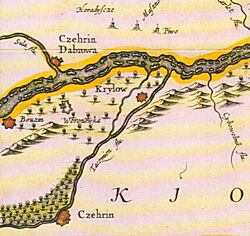Russo-Turkish War (1676–1681) facts for kids
Quick facts for kids Russo–Turkish War (1676–1681) |
|||||||
|---|---|---|---|---|---|---|---|
| Part of the Russo-Turkish wars and the Ruin | |||||||
 Czehrin at the bottom and the Dnieper through the middle of the map (the north to the left) |
|||||||
|
|||||||
| Belligerents | |||||||
| Commanders and leaders | |||||||
| Strength | |||||||
| 120,000–130,000 (maximum value, 1678 campaign) | 70,000–80,000 11,700 Chyhyryn garrison (maximum value, 1678 campaign) |
||||||
| Casualties and losses | |||||||
| 12,000–20,000 killed | 3,290 killed and 5,430 wounded in Romodanovsky’s army (according to official data); 332 killed and 1,047 wounded (according to underestimated official data; in reality, hardly less than 1,000 killed and 1,500 wounded) in the fortress garrison; Samoilovich's losses are close to those in Moscow |
||||||
The Russo-Turkish War of 1676–1681 was a conflict between the Tsardom of Russia and the Ottoman Empire. It happened because the Ottoman Empire wanted to expand its control in the late 1600s. This war is part of a longer series of conflicts between Russia and the Ottomans.
Contents
Why the War Started
After taking over the region of Podolia during the Polish–Turkish War (1672–1676), the Ottoman government wanted to control all of Right-bank Ukraine. They had the support of Hetman Petro Doroshenko, who was their ally since 1669.
However, many Ukrainian Cossacks were unhappy with Doroshenko's pro-Turkish policies. This led to the election of Ivan Samoilovich as the leader (hetman) of all Ukraine in 1674. Samoilovich was the hetman of Left-bank Ukraine.
Even with Samoilovich elected, Doroshenko still held Chyhyryn. This was an important Cossack town near the Dnieper river. Doroshenko was clever, playing Moscow (Russia) and Warsaw (Poland) against each other. He also used the help of the Turkish and Tatar armies.
Finally, in 1676, Russian and Ukrainian forces led by Samoilovich and Grigory Romodanovsky surrounded Chyhyryn. They forced Doroshenko to give up. After leaving some soldiers in Chyhyryn, the Russian and Ukrainian armies went back to the left bank of the Dnieper.
The 1677 Fight for Chyhyryn
The Ottoman Sultan Mehmed IV made Yuri Khmelnitsky the new hetman of Right-bank Ukraine. Khmelnitsky had been a prisoner of the sultan.
In July 1677, the sultan ordered his army of 45,000 men, led by Ibrahim Pasha, to march towards Chyhyryn. On July 30, their first groups arrived at the fortress. By August 3, the main Turkish forces were there.
Samoilovich and Grigory Romodanovsky's army joined up on August 10. They finally crossed the Sula river on August 24, heading to Chyhyryn. On August 26–27, a small fight helped the Russian and Ukrainian forces cross the river safely.
Russian and Ukrainian cavalry attacked the Turkish-Tatar army camp on August 28. They caused many losses. The next day, Ibrahim Pasha stopped surrounding Chyhyryn and quickly retreated. Samoilovich and Romodanovsky successfully helped Chyhyryn on September 5. The Ottoman Army lost 20,000 men. Ibrahim was put in prison when he returned home, and the Crimean Khan Selim I Giray lost his position.
The 1678 Chyhyryn Siege
In July 1678, a large Turkish army (about 70,000 men) led by Grand Vizier Kara Mustafa attacked Chyhyryn again. They were joined by a Crimean Tatar army of up to 50,000 men.
The Russian and Ukrainian armies (70,000–80,000 men) broke through the Turkish defenses. They then dug in on the left bank of the Tiasmyn river, across from the fortress. The Turkish-Crimean army was on the other side.
It was hard for the Russians to attack the Turks because the river crossings were destroyed. However, Russian troops could still enter Chyhyryn. But the city was surrounded by strong siege positions and heavily bombed. Its walls were badly damaged.
On August 11, the Turks broke into the Lower Town of Chyhyryn. Romodanovsky ordered his troops to leave the main fortress and move to the left bank of the river. The Russian army retreated beyond the Dnieper river. They fought off the chasing Turkish army until the Turks finally left them alone. Later, the Turks took Kanev and put Yuri Khmelnitsky in charge of Right-bank Ukraine. However, they did not go to Kiev, where Russian troops were stationed.
From 1679 to 1680, the Russians fought off attacks from the Crimean Tatars. On January 3, 1681, they signed the Bakhchisaray Peace Treaty. This treaty set the Dnieper river as the border between Russia and the Ottoman Empire.
What Happened After the War
The outcome of the war, which ended with the Treaty of Bakhchisarai, is still debated by historians. Some historians believe it was a victory for the Ottoman Empire. Others say it was a Russian victory. Still, other historians think the war ended in a draw, meaning neither side truly won.


